 to launch PhotoFolio.
to launch PhotoFolio.
| A more detailed look at PhotoFolio |
|
PhotoFolio has an interface that although at first you may find confusing, offers a powerful way to organize your image collection.
Toolbars in the major windows provide shortcuts to the most used functions. Context menus hide provide many functions that relate to the item the mouse is over when selected. You can drag and drop icons from the Workbench directly onto the major windows of PhotoFolio. Key commands and online help round out the MUI interface.
PhotoFolio is internally multi-threaded. That is when you may do more than one thing simultaneously. For example you can be loading a browse window with proofs and double click a proof to show it in a show window. While the browse window is still loading and the show window is loading your full image you can start a make window building proofs. This sounds comlicated but it is all handled internally. The only limit is your system resources (e.g. memory and cpu power).
Double click ![]() the camera icon
the camera icon  to launch PhotoFolio.
to launch PhotoFolio.
Note that the final appearance of PhotoFolio depends upon your MUI settings. e.g. Buttons may or may not have rounded corners.
| Main (listtree) window |
After successfully loading, PhotoFolio displays the following window.
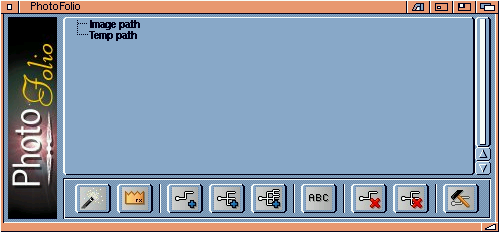
This window is the central control window or listtree window of PhotoFolio.
Here you can add paths to display in browse windows. Think of the listtree window
as a directory of paths. The paths however can be any you choose!
| Browse window |

Note that you may or may not see the attribute panel on the left of the window depending on your settings.
The browse window is where you see the proof size images of your files. You can drop paths from the main window
onto a browse window or drop WorkBench icons (drives and directories) onto the browse window. Proofs can be dragged
and dropped between browse windows. If you right click on a proof you will get a context menu that gives options for
that proof. If you right click on blank space in a browse window the context menu shows options available for selected
proofs. Double clicking a proof opens the image into a show window.
| Change proof attributes window |
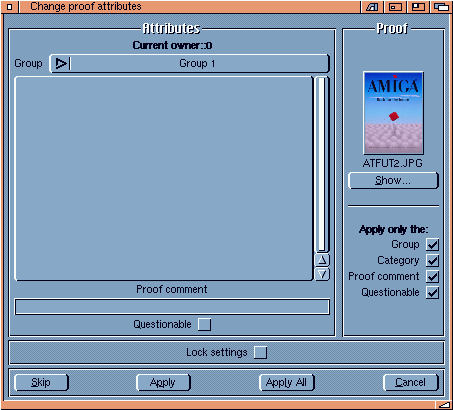
The change proof attributes window allows changes to attributes that are stored with a proof. For example you can categorize
your images, using groups and categories. You may then view your images by category.
| Internal show window |
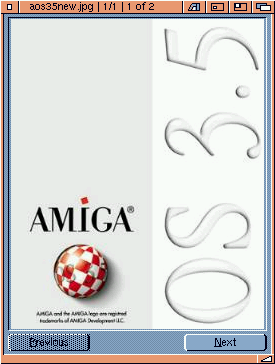
The internal show window is able to show images on any Amiga screen mode supported by any RTG board. This is done
via guigfx.library. Single proofs or multiply selected proofs
may be dragged from a browse window and dropped onto a show window to load them. Workbench icons (files) may also be
dropped onto a show window. If the show window sees it is an image file it will attempt to load it. The image may be
scaled to a number of sizes on loading so it may fit on the screen.
| MysticView show window |
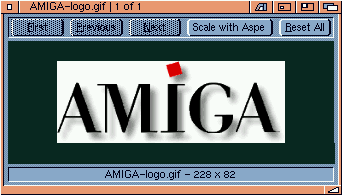
If you are familiar with MysticView you can use the PhotoFolio settings window to change the default viewer to MysticView and
all of its facilities available for use.
| Make proof window |
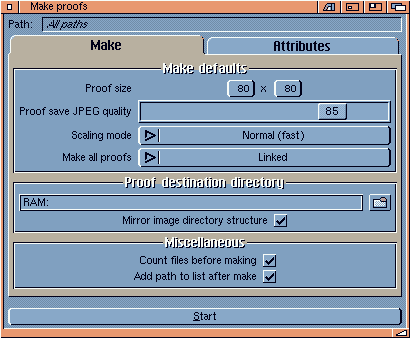
To enable proofs to be generated and stored without opening a browse window you can use this window. It allows
you to set all the options related to proof creation and then creates the proofs in the background. You may still use
PhotoFolio to browse directories and even run multiple make proofs simultaneously (subject to the availability of system
resources).
| Pattern select window |

This window is to aid in the selection of proofs in a browse window. You can use preset selections from the settings window
or enter your own directly. Proofs are matched with AmigaDOS pattern selection, the as from a Shell.
| Settings window |
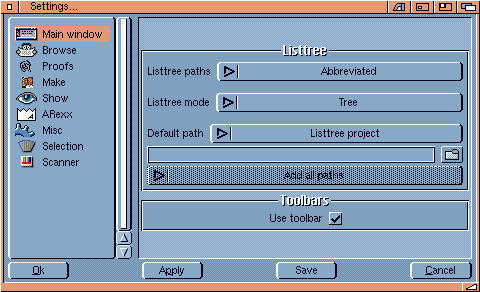
The settings window allows all the default attributes for PhotoFolio to be configured. If opened from the main window, it sets the defaults for all windows that will be opened. If opened from a browse window, the settings apply only to that browse window.